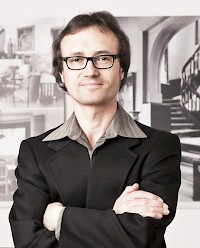Vita
Peter Heinrich Jahn studied Byzantine, Medieval and modern art history, modern German literature and Medieval history at Ludwig-Maximilians-University (LMU) in Munich. From 1996 to 1998 he worked as a research assistant at the office for public relations of the Bavarian State Office for the Preservation of Monuments (Bayerisches Landesamt für Denkmalpflege), and in 2000 at the Zentralinstitut für Kunstgeschichte in Munich on a pilot project for an International Summer Academy (»A Century of Progress – the Arts in the Era of the Great International Exhibitions 1851-1939«). In 1998 he participated in a summer school held by the Bibliotheca Hertziana – Max-Planck-Institute of Art History in Rome on »The Union of the Visual Arts during the High Baroque Period,« and again in 2004 on »Filippo Juvarra.« Since 1998 he has worked with the baroque program of the Museum With No Frontiers, an NGO in Brussels. He earned his PhD in 2006 at the University of Augsburg with a thesis on the sacral buildings of the Austrian baroque architect Johann Lucas von Hildebrandt (1668-1745), supervised by Andreas Tönnesmann. Since 2004 he has been lecturer in architectural history at the Technical Universities of Munich and Dresden as well as at the LMU in Munich and the Universität Hamburg. Since 2008 he has been engaged in the museum project »Zwingerteam – computer based 3D-Visualization of Planning and Building Phases of Dresden’s Zwinger Court« by the Saxon State Administration of Public Castles and Gardens (Staatliche Schlösser, Burgen & Gärten Sachsen) in Dresden. At the IKKM he is pursuing the research project »Imitatio & disegno geometrico. Concepts of Invention and Planning Process in the Work of the Roman Architect Carlo Fontana (1638-1714) and his School,« which is part of the research fellow program »Tools of Drafting.«
Dated from 2011
IKKM Research Project
imitatio & disegno geometrico. Idea of Invention and Planning Process of the Roman Architect Carlo Fontana (1638-1714) and his School
As has been known for a long time, the papal architect Carlo Fontana (1638-1714) – the most important pupil of the famous Gian Lorenzo Bernini (1598-1680) – played a key role in the international dissemination of late Roman baroque architecture, as he trained numerous pupils from abroad, including such illustrious names as Johann Bernhard Fischer von Erlach (1656-1723), Johann Lucas von Hildebrandt (1668-1745) and Filippo Juvarra (1678-1736). It is also well known that he promoted the professionalization of architects, maintaining a huge studio organized by division of labor comparable to today’s architectural studios; and further, that when he visualized his projects by drawing he preferred the factual-objective orthogonal projection – which he called »disegno geometrico« – instead of the suggestive perspective; and, finally, that he practiced and propagated a synthesizing method of planning based on the rhetoric principle of »imitatio,« in this case meaning a combination of parts and motifs from canonized architectural models passed down from Antiquity with those from the early modern period. Despite these insights about four core aspects of Carlo Fontana’s importance for architectural history, research on this topic to date has produced unsatisfactory results, because the functioning of neither his planning process nor his practice of orthogonal projection, nor of the way these aspects are connected, has been investigated systematically. The research project on this topic pursued at the IKKM will help to fill this gap in the path to perception by revealing deeper insights concerning the practical role of orthogonally projected architectural drawing in the architect’s workshop, as well as its mediality and therefore its agency within the planning process, resulting in a design process that is normatively determined by a canon of models.
Profile
- Early modern practices of architectural designing and planning
- Correlation between architectural planning and building processes during the early modern era
- Architecture as visual medium (architectural iconology)
- Constitution of theory in architectural history during the late 19th/early 20th century
- Education of artists and architects and their travels as a means of forming and elaborating their personal styles
- Architecture of the international Roman late baroque, especially its impact on Southern Germany, including Austria-Bohemia
- Early baroque architecture and stucco ornamentation in Southern Germany including Tyrol, focusing on the reception of Italian shapes and models Computer-based didactics of art and architecture
